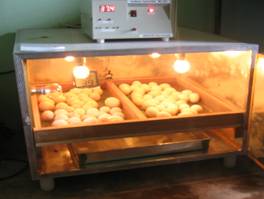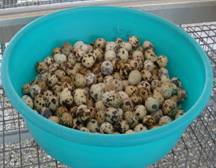 |
||||||||||||||||||
| Major Activities |
Technologies:: Incubator:: Chicken, Duck, Quail, Turkey |
|||||||||||||||||
CHICKEN Hatching of Egg Incubation Humidity in the incubator affects hatchability. Dry and wet bulb thermometers are used for measuring humidity. In fowls egg takes about 21 days to hatch. The relative humidity should be around 60 per cent during the first 18 days of incubation and 70 per cent in the last 3 days for optimum hatchability. In the forced draft-type incubators the· temperature requirement decreases as the humidity increases. Fertile eggs are loaded into the incubator with broad end up. Hatchability decreases when eggs are placed in the incubator with narrow end up as the embryo develops with its head in the small end . Turning or eggs in the incubator improves hatchability. Eggs should be turned at least 4 times during a day when turning is done by hand. Modem incubators are provided with devices for automatic turning of eggs at least 8 times or more during 24 hours. In this egg trays turn through an angle of 90°. No turning is required after 18 days of incubation. Use of separate hatcher improves hatchability. When separate hatcher is used temperature is maintained at about 98°F and relative humidity at 70 to 80 per cent to obtain good hatch. Use of separate hatcher facilitates cleaning, disinfection and fumigation without disturbing other eggs. Testing of Incubated Eggs
Incubator ( Source: KVK, Namakkal ) Hatchery ManagementAt the beginning of hatching season the incubator and hatchers should be thoroughly checked for their functioning and defects, if any, rectified. They should be properly cleaned, disinfected and fumigated to kill disease organisms before storing and after transfer of eggs to the hatcher. This reduces the incidence and spread of diseases. Fumigation is usually done with formaldehyde gas using 40 ml of 40 per cent commercial formalin and 20 g of potassium permanganate for each 2·8 m3 of space inside the incubator or hatcher. Potassium permanganate may be placed in a glass or earthenware container and formalin poured over it. Fumigation should preferably be done-at the end of the working day and then the rooms closed. It is a good practice to start the incubator and the hatcher at least 24 hours before setting the eggs to maintain a constant temperature. Persons working in the hatchery should use showers, and change clothes and shoes before entering. Receipt of eggs from the farm and the delivery of chicks should be away from each other to reduce infection. When electric supply is uncertain use of a standby generator is advocated. (Source: Dr.Acharya, Handbook of Animal Husbandry) DUCK Incubation Hatching eggs should be stored in an atmosphere having a temperature of 14oC to 16oC with a relative humidity of 80%. Eggs can be incubated in forced draft incubator with the same temperature for chicken. However, the humidity requirement is higher. This can be achieved by sprinkling lukewarm water from the second day to 23rd day of incubation. Eggs should be turned at least 4 times daily up to the 24th day of incubation. On 24th day of incubation the eggs should be transferred to hatchery. In forced draft incubators satisfactory results are attained at a temperature of 37.5 to 37.2oC (99.5 to 99oF). The wet-bulb reading on the thermometer should be 30 to 31oC (86 to 88oF) during incubation for the first 25 days and 32.7 to 33.8oC (90 to 92oF) for the last three days of hatching. Eggs are sprinkled with lukewarm water having sanitizer once a day from 2nd day to 25th day and cooled for a maximum period of half an hour. Candling is done on 7th day. The eggs are turned hourly. Eggs are transferred to hatchery on 25th day. QUAIL Care of hatching eggs
( Source: KVK, Namakkal ) TURKEY Incubation: (a) Natural incubation with broody hens: (b) Artificial Incubation:
Egg should be turned at hourly intervals daily. Eggs should be collected frequently to prevent soiling and breakage and also to get better hatchability. (Source: Farm Digest, Canara Bank(July-September,2008) |
||||||||||||||||||
Technologies |
||||||||||||||||||
Veterinary Services |
||||||||||||||||||
| Home | Success Stories | Publication | Gallery | Forms | FAQs | Related Links | Contact | |
||||||||||||||||||
| © All Rights Reserved. TNAU-2008. |
||||||||||||||||||


